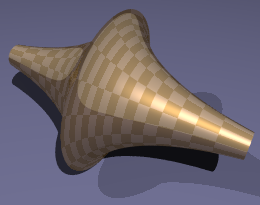User:WillemienH/Draft Pseudosphere new
New draft of great enlargement of Pseudosphere
start with version 12/03/2016 new references
- virtual math museum - wolfram demo project - stackechange questions
- riemans hab
---start---
In geometry, the term pseudosphere is used to describe various surfaces with constant negative Gaussian curvature. Depending on context, it can refer to either a theoretical surface of constant negative curvature, to a tractricoid, or to a hyperboloid.
Theoretical pseudosphere
[edit]In its general interpretation, a pseudosphere of radius R is any surface of curvature −1/R2, by analogy with the sphere of radius R, which is a surface of curvature 1/R2. The term was introduced by Eugenio Beltrami in his 1868 paper on models of hyperbolic geometry.[1]
Tractricoid
[edit]
The term is also used to refer to a certain surface called the tractricoid: the result of revolving a tractrix about its asymptote. As an example, the (half) pseudosphere (with radius 1) is the surface of revolution of the tractrix parametrized by[2]
It is a singular space (the equator is a singularity), but away from the singularities, it has constant negative Gaussian curvature and therefore is locally isometric to a hyperbolic plane.
The name "pseudosphere" comes about because it is a two-dimensional surface of constant negative curvature just like a sphere with positive Gauss curvature. Just as the sphere has at every point a positively curved geometry of a dome the whole pseudosphere has at every point the negatively curved geometry of a saddle.
As early as 1693 Christiaan Huygens found that the volume and the surface area of the pseudosphere are finite,[3] despite the infinite extent of the shape along the axis of rotation. For a given edge radius R, the area is 4πR2 just as it is for the sphere, while the volume is 2/3πR3 and therefore half that of a sphere of that radius.[4][5]
Universal covering space
[edit]The half pseudosphere of curvature −1 is covered by the portion of the hyperbolic upper half-plane with y ≥ 1.[6] The covering map is periodic in the x direction of period 2π, and takes the horocycles y = c to the meridians of the pseudosphere and the vertical geodesics x = c to the tractrices that generate the pseudosphere. This mapping is a local isometry, and thus exhibits the portion y ≥ 1 of the upper half-plane as the universal covering space of the pseudosphere. The precise mapping is
where is the arclength parametrization of the tractrix above.
Hyperboloid
[edit]In some sources that use the hyperboloid model of the hyperbolic plane, the hyperboloid is referred to as a pseudosphere.[7] This usage of the word is because the hyperboloid can be thought of as a sphere of imaginary radius, embedded in a Minkowski space.
See also
[edit]- Dini's surface
- Gabriel's Horn
- Hyperboloid
- Hyperboloid structure
- Sine–Gordon equation
- Sphere
- Surface of revolution
References
[edit]- ^ Beltrami, Eugenio (1868), "Saggio sulla interpretazione della geometria non euclidea", Gior. Mat. (in Italian), 6: 248–312
(Also Beltrami, Eugenio, Opere Matematiche (in Italian), vol. 1, pp. 374–405, ISBN 1-4181-8434-9;
Beltrami, Eugenio (1869), "Essai d'interprétation de la géométrie noneuclidéenne", Annales de l'École Normale Supérieure (in French), 6: 251–288) - ^ Bonahon, Francis (2009). Low-dimensional geometry: from Euclidean surfaces to hyperbolic knots. AMS Bookstore. p. 108. ISBN 0-8218-4816-X., Chapter 5, page 108
- ^ Mangasarian, Olvi L.; Pang, Jong-Shi (1999). Computational optimization: a tribute to Olvi Mangasarian, Volume 1. Springer. p. 324. ISBN 0-7923-8480-6., Chapter 17, page 324
- ^ Le Lionnais, F. (2004). Great Currents of Mathematical Thought, Vol. II: Mathematics in the Arts and Sciences (2 ed.). Courier Dover Publications. p. 154. ISBN 0-486-49579-5., Chapter 40, page 154
- ^ Weisstein, Eric W. "Pseudosphere". MathWorld.
- ^ Thurston, William, Three-dimensional geometry and topology, vol. 1, Princeton University Press, p. 62.
- ^ Hasanov, Elman (2004), "A new theory of complex rays", IMA J Appl Math, 69: 521–537, doi:10.1093/imamat/69.6.521, ISSN 1464-3634
- Stillwell J: Sources of Hyperbolic Geometry, 1996, Amer. Math. Soc & London Math. Soc.
- Henderson, D. W. and Taimina, D. (2006). "Experiencing Geometry: Euclidean and Non-Euclidean with History". Aesthetics and Mathematics. Springer-Verlag.
{{cite book}}: External link in|chapter= - Edward Kasner & James Newman (1940) Mathematics and the Imagination, pp 140,145,155, Simon & Schuster.
External links
[edit]- Non Euclid
- Crocheting the Hyperbolic Plane: An Interview with David Henderson and Daina Taimina
- Prof. C.T.J. Dodson's web site at University of Manchester
- Interactive demonstration of the pseudosphere (at the University of Manchester)
- Norman Wildberger lecture 16, History of Mathematics, University of New South Wales. YouTube. 2012 May.
- Pseudospherical surfaces at the virtual math museum.
categories
[edit](remove title ane reformat) --Category:Differential geometry]]
--Category:Hyperbolic geometry]]
--Category:Surfaces]]



